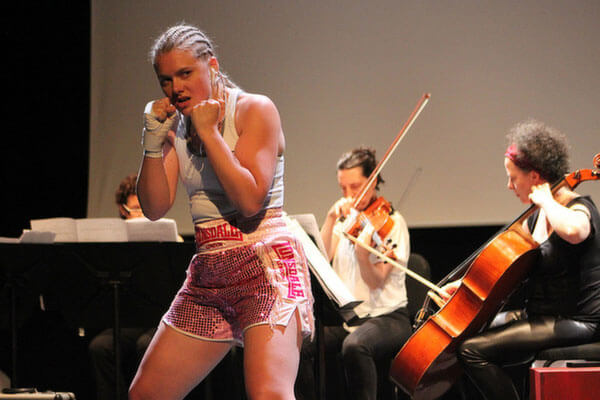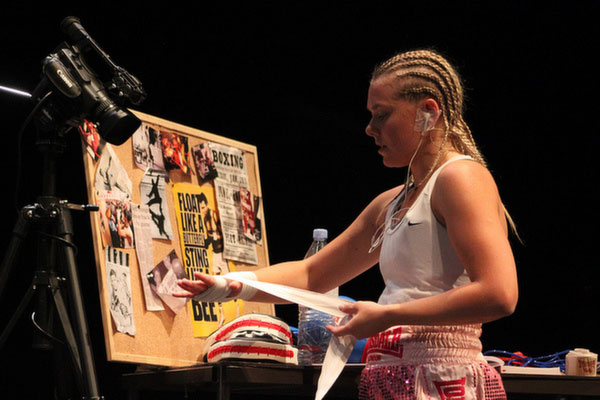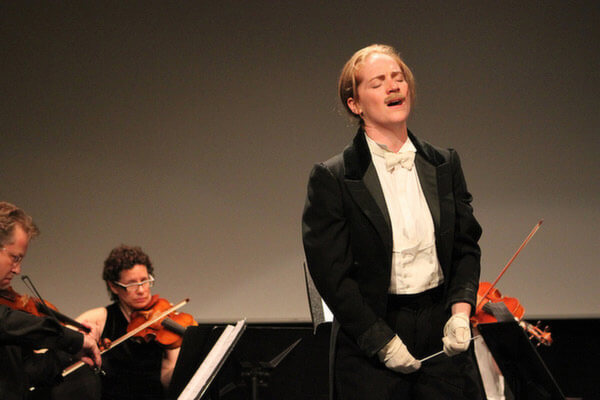
Step forward, Laura J. Bowler. Training is the Opposite, a new short opera by Jennifer Walshe, asks considerably more of its solo mezzo-soprano than most other pieces would dare. Bowler has been in training—proper boxing training—with Cathy “The Bitch” Brown, a former world number three boxer, in preparation: the work essentially consists of her doing a boxing training routine, and singing, accompanied by a string quartet. To be fair to Walshe, she hasn’t asked Bowler to do anything beyond what she’d do herself: she took boxing lessons, too.

Laura J. Bowler – Photo by Claire Shovelton
This sounds a bit like a daft, headline-grabbing stunt. What elevates it way beyond this is how real it is. This may have been a stage show, but the punches were real. The sweat was real. I’d bet a fair number of the swear words were real, too. It depicted a training session, but let’s be in no doubt: this was the main event.
Let’s remember, in fact, that this performance was way tougher than any “real” training session could possibly be: the precise movements were choreographed (by Brown herself, in fact). There was no opportunity for a break. Did I mention she had to sing during it too?
This is 21st-century virtuosity. It is very impressive.

Laura J. Bowler – Photo by Claire Shovelton
What’s more, Training is the Opposite was in fact only one part of this event, which I saw at the Tête à Tête festival for contemporary opera at London’s Kings Place. As a whole, it was put on by Bowler’s company Size Zero Opera, called Women Box, and additionally featured Mauricio Kagel’s first two string quartets, which bookended both Walshe’s piece and one by Bowler herself entitled Women Conduct. All were performed by the excellent Quatuor Bozzini, over from Canada for the occasion, and the solo singer in Women Conduct was Úna McMahon, whose performance was arguably just as trying as all the boxing.
In Women Conduct, McMahon takes to the stage doing a Gustav Mahler impression, complete with mustache (?), white tie and baton. After a small amount of music and quite a lot of simulated masturbation, she removes her moustache and enters into a gender-based identity crisis, finding it impossible to succeed as a conductor as she is: she loses the respect of her musicians along the way and at the end is reduced to stripping down to her lingerie, donning a ball gag and waving a fairy’s wand about—and when she tries to conduct like that, all that comes out of the quartet is a girly nursery rhyme.

Úna McMahon – Photo by Claire Shovelton
It’s a nightmarish insight into the challenges women face when trying to advance in male-dominated areas, and if it sounds quite unsubtle, this was mitigated in performance by the high quality of everything about it, from the text (Sam Redway) to the direction (Matthew Monaghan) to the performance. And of course Bowler’s music, which rarely took centre stage but was witty, subtle, and artful, even when quoting Mahler 5.
What made Women Conduct more effective still was the sharp contrast it drew with its companion piece. The vivid depiction of female struggle in Women Conduct stood in opposition to the aggressively proactive Training is the Opposite, which came across as a tribute to the fierce focus and power of Cathy “The Bitch” Brown. Bowler jabbed, yelled, threatened; she goaded herself on through watching videos, doing sit-ups, shouting insults into the crowd. And, just as importantly, she meditated, from time to time, holding a pose still for a while and singing long, pure tones. In the closing stages, these two strands—the aggressive and the meditative—came together compellingly as she mimed a slow-motion bout with an invisible opponent, soundtracking herself by chanting training mantras. This piece quickly moved beyond the gender issue—it was a tribute to mental fortitude and determination.
Úna McMahon – Photo by Claire Shovelton
Quatuor Bozzini’s contribution to Training, while often seemingly unconnected to Bowler’s, contained similar levels of aggression—at one point the cellist drew a gun and pointed it at her fellow players, and several of them angrily swiped at their music stands. They took to the physicality of this piece perfectly, as they did to the Kagel quartets as well, both similarly concerned with the line beyond live music and performance art. That said, the second quartet (subtler than the first) was an anticlimactic finale, coming after two such visceral short operas.
After all, there was more than enough to take away from the two operas alone. Together, they offered contrasting perspectives on modern feminism, firstly celebrating woman’s power to achieve in a traditionally masculine field, but secondly querying the value of this: “My archetypal maestro doesn’t look like me,” laments the female conductor at the end of Bowler’s piece, defeated by a system rigged in favour of traditionally masculine qualities. It’s a provocative ending—but not pessimistic, only because the quality of McMahon, Bowler and Walshe’s work proves that men do not have a monopoly on artistic excellence.
Women Box has a life beyond the ever-excellent Tête à Tête festival, which seems to fit like a glove (boxing glove?) into its new pair of venues, Kings Place and Central Saint Martins. The piece is moving on to the Grimeborn festival at the Arcola Theatre, also in London, for three performances from 26 August—in a slightly adapted form incorporating a new piece by Anna Meredith, and with the Ligeti Quartet in place of the Bozzinis. If it’s anything like the Kings Place performances, it will be well worth experiencing if you can.
